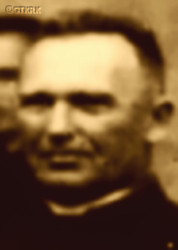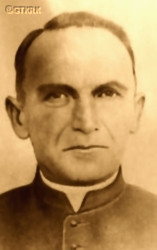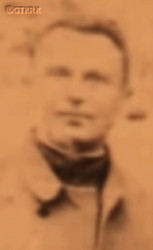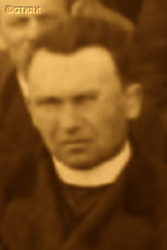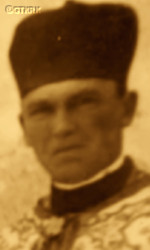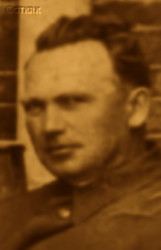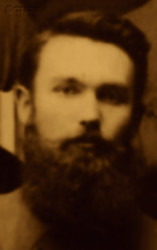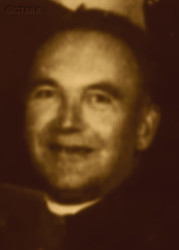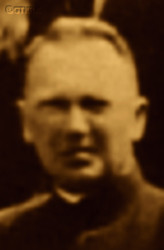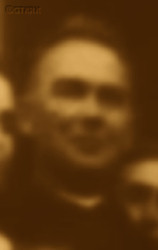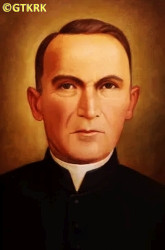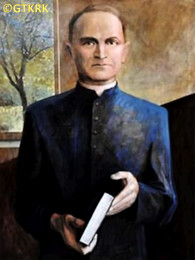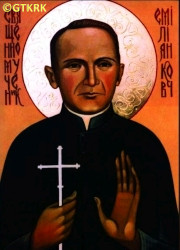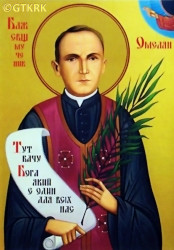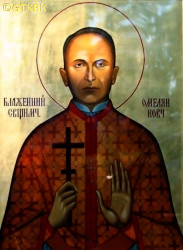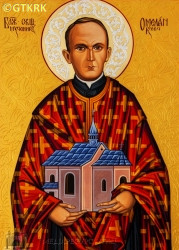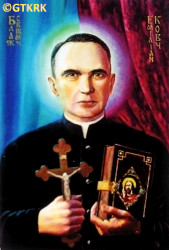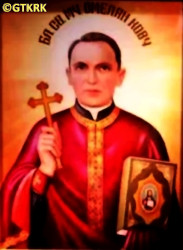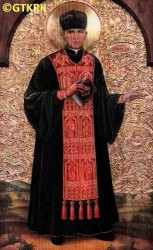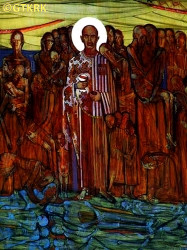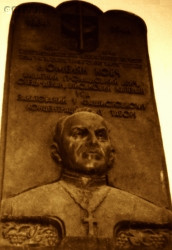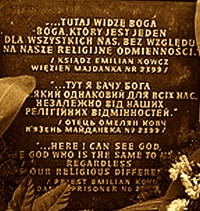Roman Catholic
St Sigismund parish
05-507 Słomczyn
85 Wiślana Str.
Konstancin deanery
Warsaw archdiocese, Poland
full list:
displayClick to display full list

searchClick to search full list by categories
wyświetlKliknij by wyświetlić pełną listę po polsku

szukajKliknij by przeszukać listę wg kategorii po polsku

Martyrology of the clergy — Poland
XX century (1914 – 1989)
personal data
religious status
blessed
surname
KOWCZ
forename(s)
Emilian
beatification date
27.06.2001more on
www.swzygmunt.knc.pl
[access: 2013.05.19]

the RC Pope John Paul IImore on
en.wikipedia.org
[access: 2014.09.21]
function
eparchial priest
creed
Ukrainian Greek Catholic GCmore on
en.wikipedia.org
[access: 2013.05.19]
diocese / province
Lviv GC archeparchymore on
en.wikipedia.org
[access: 2013.05.19]
Stanyslaviv GC eparchymore on
en.wikipedia.org
[access: 2013.05.19]
nationality
Ukrainian
date and place
of death
25.03.1944

KL Lublinconcentration camp
today: Majdanek‐Lublin, Lublin city pov., Lublin voiv., Poland
more on
en.wikipedia.org
[access: 2022.01.09]
details of death
In 1919‐1920 chaplain of the Ukrainian Galician Army UHA — during Polish–Ukrainian war of 1918‐1919 and Polish–Russian war of 1919‐1921.
Chaplain of so‐called Bzhezhany group, prob. part of 3rd UHA Infantry Regiment.
In c. 1920 interned by Polish authorities in one of the internment camps for Ukrainians.
Released at the end of 1920, after Russian defeat in Warsaw battle with Poles (08.1920).
Mid–wars, in independent Poland for his pro–Ukrainian stance many times stopped by the Polish police — among others fined and sentenced to a time in prison, spent partly in Assumption of the Blessed Virgin Mary monastery in Univ.
After German and Russian invasion of Poland in 09.1939 and start of the World War II, after start of Russian occupation, help and supported persecuted Poles and Ukrainians and their families.
After German attack on 22.06.1941 of their erstwhile ally, Russians, arrested by the Russians, together with two of his daughters.
Luckily escaped and managed to stay hidden until German arrival.
After commencement of German occupation helped the Jews.
Saved the rabbi of Belza, among others.
Eventually arrested by the Germans on 30.12.1942 — for sheltering, providing with baptism certificates and helping the Jews.
Jailed in Łąckiego prison in Lviv.
Tortured.
Finally on 31.08.1943 transported to the German KL Lublin (Majdanek) concentration camp.
There he known as „Majdanek's pastor” and there he perished — exhausted and suffering from phlegmone.
prisoner camp's numbers
2399 (KL Lublin (Majdanek)Click to display the description)
cause of death
extermination
perpetrators
Germans
sites and events
KL Lublin (Majdanek)Click to display the description, Lviv (Łąckiego)Click to display the description, Help to the JewsClick to display the description, 06.1941 massacres (NKVD)Click to display the description, Ribbentrop‐MolotovClick to display the description, Pius XI's encyclicalsClick to display the description, Polish‐Russian war of 1919‐1921Click to display the description, Polish‐Ukrainian war of 1918‐1919Click to display the description
date and place
of birth
20.08.1884

Kosmachtoday: Kosmach hrom., Kosiv rai., Stanislaviv/Ivano‐Frankivsk obl., Ukraine
more on
en.wikipedia.org
[access: 2022.08.05]
parents
KOWCZ Gregory
🞲 1856/1861, ? — 🕆 1919, Starokostiantynivtoday: Starokostiantyniv urban hrom., Proskuriv/Khmelnytskyi rai., Proskuriv/Khmelnytskyi obl., Ukraine
more on
en.wikipedia.org
[access: 2021.09.17]

JAŚKIEWICZ-WOLFELD Mary
🞲 ?, ? — 🕆 1939, ?
presbyter (holy orders)
ordination
1911

Stanislavivtoday: Ivano‐Frankivsk, Stanislaviv/Ivano‐Frankivsk rai., Stanislaviv/Ivano‐Frankivsk obl., Ukraine
more on
en.wikipedia.org
[access: 2020.11.20]
Resurrection of Christ GC cathedral churchmore on
en.wikipedia.org
[access: 2019.12.26]
positions held
1921 – 1942
parish priest — Peremyshlianytoday: Peremyshliany urban hrom., Lviv rai., Lviv obl., Ukraine
more on
en.wikipedia.org
[access: 2022.01.16] ⋄ St Nicholas the Wonderworker GC parish ⋄ Peremyshlianytoday: Peremyshliany urban hrom., Lviv rai., Lviv obl., Ukraine
more on
en.wikipedia.org
[access: 2022.01.16] GC deanery
1921 – 1942
administrator — Korosnotoday: Peremyshliany urban hrom., Lviv rai., Lviv obl., Ukraine
more on
uk.wikipedia.org
[access: 2023.03.02] ⋄ Blessed Virgin Mary GC parish ⋄ Peremyshlianytoday: Peremyshliany urban hrom., Lviv rai., Lviv obl., Ukraine
more on
en.wikipedia.org
[access: 2022.01.16] GC deanery
1921
administrator — Borshivtoday: Peremyshliany urban hrom., Lviv rai., Lviv obl., Ukraine
more on
uk.wikipedia.org
[access: 2023.03.02] ⋄ St Elijah the Prophet GC parish ⋄ Peremyshlianytoday: Peremyshliany urban hrom., Lviv rai., Lviv obl., Ukraine
more on
en.wikipedia.org
[access: 2022.01.16] GC deanery
1919 – 1920
GC military chaplain — Ukrainian Galician Army UHA
1916 – 1919
administrator — Sarnyky Verkhnetoday: part of Sarnyky village, Burshtyn urban hrom., Stanislaviv/Ivano‐Frankivsk rai., Stanislaviv/Ivano‐Frankivsk obl., Ukraine
more on
pl.wikipedia.org
[access: 2022.08.05] ⋄ Transfiguration of the Lord GC parish ⋄ Burshtyntoday: Burshtyn urban hrom., Stanislaviv/Ivano‐Frankivsk rai., Stanislaviv/Ivano‐Frankivsk obl., Ukraine
more on
en.wikipedia.org
[access: 2020.11.24] GC deanery
1912 – 1916
administrator — Kozaractoday: Republika Srpska ent., Bosnia and Herzegovina
more on
en.wikipedia.org
[access: 2022.01.17] ⋄ Exaltation of the Holy Cross GC parish — among Ruthenian diaspora
c. 1912
prefect — Pidvolochysktoday: Pidvolochysk hrom., Ternopil rai., Ternopil obl., Ukraine
more on
en.wikipedia.org
[access: 2022.01.16] ⋄ 6‐grade school for boys and girls ⋄ Holy Trinity GC church ⋄ Staromishchynatoday: Pidvolochysk hrom., Ternopil rai., Ternopil obl., Ukraine
more on
en.wikipedia.org
[access: 2022.08.05], St Nicholas GC parish ⋄ Skalattoday: Skalat urban hrom., Ternopil rai., Ternopil obl., Ukraine
more on
en.wikipedia.org
[access: 2020.11.15] GC deanery
1905 – 1911
student — Rometoday: Rome prov., Lazio reg., Italy
more on
en.wikipedia.org
[access: 2021.12.18] ⋄ theology, Pontifical Urban University (Lat. Pontificia Universitas Urbaniana), known as „Urbaniana” (from 1962), Collegium Urbanum (till 1962)
1905 – 1911
student — Rometoday: Rome prov., Lazio reg., Italy
more on
en.wikipedia.org
[access: 2021.12.18] ⋄ philosophy and theology, Ukrainian Pontifical College of St Josaphat /from 1932/, St Josaphat College /till 1932/, Pontifical Rutheanum College/till 1904/
widower — six children
others related
in death
ARCHUTOWSKIClick to display biography Roman, CHŁOPECKIClick to display biography Romualdo, KAŚCIŃSKIClick to display biography Leopold, KOZŁOWSKIClick to display biography Valery, LESZCZYKClick to display biography Anthony, MODRZEWSKAClick to display biography Hedwig Joanna Gabrielle, NIEROSTEKClick to display biography Joseph, OSIKOWICZClick to display biography Andrew, PECIAKClick to display biography Louis, TROCHAClick to display biography Peter (Bro. Adalbert Marian)
sites and events
descriptions
KL Lublin (Majdanek): Operational in 1941‐1944, in Majdanek village n. Lublin, German Germ. Konzentrationslager (Eng. concentration camp) KL and „death” camp. Prisoners were not only local, from Lublin region, but from all over pre‐war Poland and from abroad. Most of them were Jewish, but also member of Polish clandestine resistance (part of Polish Clandestine State), Polish intelligentsia, Russian POWs, inhabitants of Zamość area evicted by the Germans, people captured in round‐ups in Polish towns and cities. 6% of the prisoners were children 14 years old and younger. Prisoners slaved at c. 16 sub‐camps working for German companies, such as Deutsche Ausrüstungswerke (DAW). Altogether c. 150,000 people were held in the camp. C. 79,000 victims were murdered, among them c. 59,000 Jews. The camp was equipped with 5 gas chambers, where prisoners were mass murdered, using gas from bottles or from capsules of Zyklon B. (more on: www.majdanek.euClick to attempt to display webpage
[access: 2012.11.23], en.wikipedia.orgClick to attempt to display webpage
[access: 2013.08.10])
Lviv (Łąckiego): Prison at Łącki Str. in Lviv. Founded in 1918‐1920 by Polish authorities, mainly for political prisoners. From 1935 used as investigative jail. After German and Russian invasion of Poland in 09.1939 and start of the World War II, after start of Russian occupation Russians — local branch of Russian genocidal NKVD organisation — held thousands of prisoners, mainly Poles and Ukrainians, in prison (then prison no 1). It was also a place of carrying out death sentences passed by Russian summary courts on Poles suspected of participation in Polish clandestine resistance activities. In 06.1941, after German attack on 22.06.1941 of their erstwhile ally, Russians, NKVD agents slaugher — during genocidal massacres of prisoners — c. 924 inmates. During German occupation that followed in 1941‐1944 the prison’s buildings held German Gestapo investigative jail. It was a place of executions. In 1944‐1991, after German defeat and start of another Russian occupation, the building were again used by NKVD (and it successor MVD) as investigative jail and also investigative department. (more on: pl.wikipedia.orgClick to attempt to display webpage
[access: 2014.10.31])
Help to the Jews: During World War II on the Polish occupied territories Germans forbid to give any support to the Jews under penalty of death. Hundreds of Polish priests and religious helped the Jews despite this official sanction. Many of them were caught and murdered.
06.1941 massacres (NKVD): After German attack of Russian‐occupied Polish territory and following that of Russia itself, before a panic escape, Russians murdered — in accordance with the genocidal order issued on 24.06.1941 by the Russian interior minister Lawrence Beria to murder all prisoners (formally „sentenced” for „counter‐revolutionary activities”, „anti‐Russian acts”, sabotage and diversion, and political prisoners „in custody”), held in NKVD‐run prisons in Russian occupied Poland, Lithuania, Latvia and Estonia — c. 40,000‐50,000 prisoners. In addition Russians murdered many thousands of victims arrested after German attack regarding them as „enemies of people” — those victims were not even entered into prisons’ registers. Most of them were murdered in massacres in the prisons themselves, the others during so‐called „death marches” when the prisoners were driven out east. After Russians departure and start of German occupation a number of spontaneous pogroms of Jews took place. Many Jews collaborated with Russians and were regarded as co‐responsible for prison massacres. (more on: en.wikipedia.orgClick to attempt to display webpage
[access: 2021.12.19])
Ribbentrop‐Molotov: Genocidal Russian‐German alliance pact between Russian leader Joseph Stalin and German leader Adolf Hitler signed on 23.08.1939 in Moscow by respective foreign ministers, Mr. Vyacheslav Molotov for Russia and Joachim von Ribbentrop for Germany. The pact sanctioned and was the direct cause of joint Russian and German invasion of Poland and the outbreak of the World War II in 09.1939. In a political sense, the pact was an attempt to restore the status quo ante before 1914, with one exception, namely the „commercial” exchange of the so‐called „Kingdom of Poland”, which in 1914 was part of the Russian Empire, fore Eastern Galicia (today's western Ukraine), in 1914 belonging to the Austro‐Hungarian Empire. Galicia, including Lviv, was to be taken over by the Russians, the „Kingdom of Poland” — under the name of the General Governorate — Germany. The resultant „war was one of the greatest calamities and dramas of humanity in history, for two atheistic and anti‐Christian ideologies — national and international socialism — rejected God and His fifth Decalogue commandment: Thou shall not kill!” (Abp Stanislav Gądecki, 01.09.2019). The decisions taken — backed up by the betrayal of the formal allies of Poland, France and Germany, which on 12.09.1939, at a joint conference in Abbeville, decided not to provide aid to attacked Poland and not to take military action against Germany (a clear breach of treaty obligations with Poland) — were on 28.09.1939 slightly altered and made more precise when a treaty on „German‐Russian boundaries and friendship” was agreed by the same murderous signatories. One of its findings was establishment of spheres of influence in Central and Eastern Europe and in consequence IV partition of Poland. In one of its secret annexes agreed, that: „the Signatories will not tolerate on its respective territories any Polish propaganda that affects the territory of the other Side. On their respective territories they will suppress all such propaganda and inform each other of the measures taken to accomplish it”. The agreements resulted in a series of meeting between two genocidal organization representing both sides — German Gestapo and Russian NKVD when coordination of efforts to exterminate Polish intelligentsia and Polish leading classes (in Germany called «Intelligenzaktion», in Russia took the form of Katyń massacres) where discussed. Resulted in deaths of hundreds of thousands of Polish intelligentsia, including thousands of priests presented here, and tens of millions of ordinary people,. The results of this Russian‐German pact lasted till 1989 and are still in evidence even today. (more on: en.wikipedia.orgClick to attempt to display webpage
[access: 2015.09.30])
Pius XI's encyclicals: Facing the creation of two totalitarian systems in Europe, which seemed to compete with each other, though there were more similarities than contradictions between them, Pope Pius XI issued in 03.1937 (within 5 days) two encyclicals. In the „Mit brennender Sorge” (Eng. „With Burning Concern”) published on 14.03.1938, condemned the national socialism prevailing in Germany. The Pope wrote: „Whoever, following the old Germanic‐pre‐Christian beliefs, puts various impersonal fate in the place of a personal God, denies the wisdom of God and Providence […], whoever exalts earthly values: race or nation, or state, or state system, representatives of state power or other fundamental values of human society, […] and makes them the highest standard of all values, including religious ones, and idolizes them, this one […] is far from true faith in God and from a worldview corresponding to such faith”. On 19.03.1937, published „Divini Redemptoris” (Eng. „Divine Redeemer”), in which criticized Russian communism, dialectical materialism and the class struggle theory. The Pope wrote: „Communism deprives man of freedom, and therefore the spiritual basis of all life norms. It deprives the human person of all his dignity and any moral support with which he could resist the onslaught of blind passions […] This is the new gospel that Bolshevik and godless communism preaches as a message of salvation and redemption of humanity”… Pius XI demanded that the established human law be subjected to the natural law of God , recommended the implementation of the ideal of a Christian state and society, and called on Catholics to resist. Two years later, National Socialist Germany and Communist Russia came together and started World War II. (more on: www.vatican.vaClick to attempt to display webpage
[access: 2023.05.28], www.vatican.vaClick to attempt to display webpage
[access: 2023.05.28])
Polish‐Russian war of 1919‐1921: War for independence of Poland and its borders. Poland regained independence in 1918 but had to fight for its borders with former imperial powers, in particular Russia. Russia planned to incite Bolshevik‐like revolutions in the Western Europe and thus invaded Poland. Russian invaders were defeated in 08.1920 in a battle called Warsaw battle („Vistula river miracle”, one of the 10 most important battles in history, according to some historians). Thanks to this victory Poland recaptured part of the lands lost during partitions of Poland in XVIII century, and Europe was saved from the genocidal Communism. (more on: en.wikipedia.orgClick to attempt to display webpage
[access: 2014.12.20])
Polish‐Ukrainian war of 1918‐1919: One of the wars for borders of the newly reborn Poland. At the end of 1918 on the former Austro‐Hungarian empire’s territory, based on the Ukrainian military units of the former Austro‐Hungarian army, Ukrainians waged war against Poland. In particular attempted to create foundation of an independent state and attacked Lviv. Thanks to heroic stance of Lviv inhabitants, in particular young generation of Poles — called since then Lviv eaglets — the city was recaptured by Poles and for a number of months successfully defended against furious Ukrainian attacks. In 1919 Poland — its newly created army — pushed Ukrainian forces far to the east and south, regaining control over its territory. (more on: en.wikipedia.orgClick to attempt to display webpage
[access: 2017.05.20])
sources
personal:
kovch.org.uaClick to attempt to display webpage
[access: 2019.12.26], pl.wikipedia.orgClick to attempt to display webpage
[access: 2013.05.19]
original images:
www.youtube.comClick to attempt to display webpage
[access: 2015.04.18], www.majdanek.euClick to attempt to display webpage
[access: 2013.06.11], www.youtube.comClick to attempt to display webpage
[access: 2015.04.18], www.youtube.comClick to attempt to display webpage
[access: 2015.04.18], www.youtube.comClick to attempt to display webpage
[access: 2015.04.18], www.youtube.comClick to attempt to display webpage
[access: 2015.04.18], www.youtube.comClick to attempt to display webpage
[access: 2015.04.18], www.youtube.comClick to attempt to display webpage
[access: 2015.04.18], www.youtube.comClick to attempt to display webpage
[access: 2015.04.18], www.youtube.comClick to attempt to display webpage
[access: 2015.04.18], photo-lviv.in.uaClick to attempt to display webpage
[access: 2019.12.26], kovch.org.uaClick to attempt to display webpage
[access: 2019.12.26], kovch.org.uaClick to attempt to display webpage
[access: 2019.12.26], kovch.org.uaClick to attempt to display webpage
[access: 2019.12.26], kovch.org.uaClick to attempt to display webpage
[access: 2019.12.26], kovch.org.uaClick to attempt to display webpage
[access: 2019.12.26], kovch.org.uaClick to attempt to display webpage
[access: 2019.12.26], photo-lviv.in.uaClick to attempt to display webpage
[access: 2019.12.26], sofija-net.plClick to attempt to display webpage
[access: 2021.12.19], www.istpravda.com.uaClick to attempt to display webpage
[access: 2019.12.26], wspolnota-polska.org.plClick to attempt to display webpage
[access: 2021.12.19], commons.wikimedia.orgClick to attempt to display webpage
[access: 2014.11.14], ugcc.org.uaClick to attempt to display webpage
[access: 2014.11.14]
LETTER to CUSTODIAN/ADMINISTRATOR
If you have an Email client on your communicator/computer — such as Mozilla Thunderbird, Windows Mail or Microsoft Outlook, described at WikipediaPatrz:
en.wikipedia.org, among others — try the link below, please:
LETTER to CUSTODIAN/ADMINISTRATORClick and try to call your own Email client
If however you do not run such a client or the above link is not active please send an email to the Custodian/Administrator using your account — in your customary email/correspondence engine — at the following address:

giving the following as the subject:
MARTYROLOGY: KOWCZ Emilian
To return to the biography press below:
 Click to return to biography
Click to return to biography








